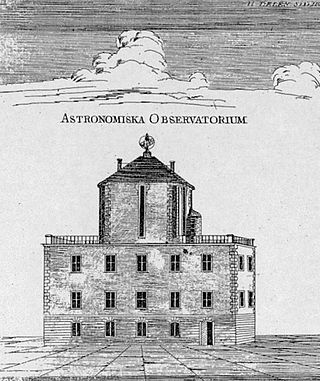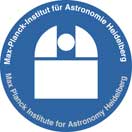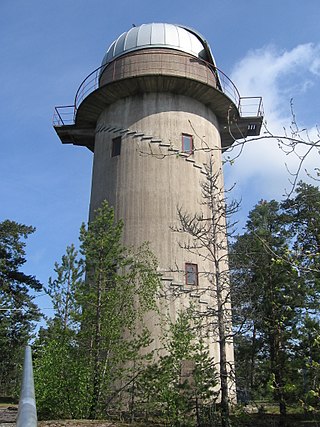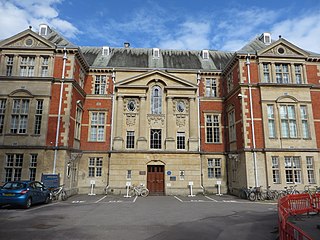
The Uppsala Astronomical Observatory (UAO), Astronomiska observatoriet i Uppsala) is the oldest astronomical observatory in Sweden. It was founded in 1741, though there was a professorial chair of astronomy at the University of Uppsala from 1593 and the university archives include lecture notes in astronomy from the 1480s.
The Max Planck Institute for Extraterrestrial Physics is part of the Max Planck Society, located in Garching, near Munich, Germany. In 1991 the Max Planck Institute for Physics and Astrophysics split up into the Max Planck Institute for Extraterrestrial Physics, the Max Planck Institute for Physics and the Max Planck Institute for Astrophysics. The Max Planck Institute for Extraterrestrial Physics was founded as sub-institute in 1963. The scientific activities of the institute are mostly devoted to astrophysics with telescopes orbiting in space. A large amount of the resources are spent for studying black holes in the Milky Way Galaxy and in the remote universe.

The Institute of Astronomy (IoA) is the largest of the three astronomy departments in the University of Cambridge, and one of the largest astronomy sites in the United Kingdom. Around 180 academics, postdocs, visitors and assistant staff work at the department.

Yousef Sobouti is a contemporary Iranian astrophysicist, theoretical physicist.

The Max-Planck-Institut für Astronomie is a research institute of the Max Planck Society (MPG). It is located in Heidelberg, Baden-Württemberg, Germany near the top of the Königstuhl, adjacent to the historic Landessternwarte Heidelberg-Königstuhl astronomical observatory. The institute primarily conducts basic research in the natural sciences in the field of astronomy.

Bryan Malcolm Gaensler is an Australian astronomer based at the University of California, Santa Cruz. He studies magnetars, supernova remnants, and magnetic fields. In 2014, he was appointed as Director of the Dunlap Institute for Astronomy & Astrophysics at the University of Toronto, after James R. Graham's departure. He was the co-chair of the Canadian 2020 Long Range Plan Committee with Pauline Barmby. In 2023, he was appointed as Dean of Physical and Biological Sciences at UC Santa Cruz.
Catharine "Katy" D. Garmany is an astronomer with the National Optical Astronomy Observatory. She holds a B.S. (astrophysics), 1966 from Indiana University; and a M.A. (astrophysics), 1968, and Ph.D. (astronomy), 1971, from the University of Virginia. Catharine's main areas of research are massive stars, evolution and formation; astronomical education.
Vytautas Straižys was a Lithuanian astronomer. In 1963–65 he and his collaborators created and developed the Vilnius photometric system, a seven-color intermediate band system, optimized for photometric stellar classification. In 1996 he was elected a Corresponding Member of the Lithuanian Academy of Sciences. Straižys was an editor of the journal Baltic Astronomy. He spent a lot of time working at the Molėtai Astronomical Observatory. Asteroid 68730 Straizys in 2002 was named after him.

Tuorla Observatory is the Department of Astronomy at the University of Turku, southwest Finland. It is the largest astronomical research institute in Finland. Together with the Space Research Laboratory at the Physics Department of the University of Turku, it forms the Väisälä Institute of Space Physics and Astronomy (VISPA).
Eric J. Chaisson is an American astrophysicist known for his research, teaching, and writing on the interdisciplinary science of cosmic evolution. He is a member of the Center for Astrophysics | Harvard & Smithsonian, teaches natural science at Harvard University and is an elected Fellow of the American Association for the Advancement of Science.

The Dearborn Observatory is an astronomical observatory located on the Evanston campus of Northwestern University. The observatory was originally constructed in 1888, through an agreement between the university and the Chicago Astronomical Society. In the summer of 1939, Dearborn Observatory had to be moved to make way for the construction of the Technological Institute.

Anders Jonas Ångström was a Swedish physicist and one of the founders of the science of spectroscopy.
The Institute of Space and Planetary Astrophysics, also known as by its abbreviation ISPA, is a premier and national research institute of the University of Karachi, engaging the theoretical and applied studies and research into topics pertaining to Astronomy, Astrophysics, Satellite Communication, Space Flight Dynamics, Atmospheric Science, Climatology, GIS & Remote Sensing and other related subjects. The institute has network of various mathematics and physics laboratories located in various universities of Pakistan, while it operates a single Karachi University Astrophysics Observatory.
Patrick Thaddeus was an American professor and finished his career as the Robert Wheeler Willson Professor of Applied Astronomy Emeritus at Harvard University. He is best known for mapping carbon monoxide in the Milky Way galaxy and was responsible for the construction of the CfA 1.2 m Millimeter-Wave Telescope.

The Department of Physics at the University of Oxford is located on Parks Road in Oxford, England. The department consists of multiple buildings and sub-departments including the Clarendon Laboratory, Denys Wilkinson's building, Dobson Square and the Beecroft building. Each of these facilities contribute in studying different sub-types of physics such as Atomic and Laser Physics, Astrophysics, Theoretical Physics, etc. The physics division have made scientific contributions towards this branch of science since the establishment of the department.

The ESO Supernova Planetarium & Visitor Centre is an astronomy centre located at the site of the European Southern Observatory (ESO) Headquarters in Garching bei München. It offers exhibitions, guided tours and planetarium shows that feature observations made by the telescopes of the European Southern Observatory.

Skinakas Observatory is an astronomical observatory located on the eponymous peak of Psiloritis, on the island of Crete, Greece. It has a 1.3 m modified Ritchey–Chrétien telescope and a 0.3 m Schmidt–Cassegrain telescope, which are operated by the University of Crete and the Foundation for Research & Technology – Hellas.
Johanna Sofia Nikolina Feltzing is a Swedish astronomer and Professor of Astronomy at Lund University since 2011. She completed her PhD at Uppsala University in 1996, publishing a dissertation about the chemical evolution of the Milky Way. Feltzing was the first woman to complete a PhD in astronomy at Uppsala, and the tenth in Sweden. She was a postdoctoral researcher at Royal Greenwich Observatory and the Institute of Astronomy, Cambridge at Cambridge University from 1996 to 1998. In 1998, she moved to Lund Observatory.

Brad Gibson is a retired Australian-Canadian astrophysicist. He is known for identifying the regions of the Galaxy most likely to harbor complex biological life, designing and constructing the first operational liquid mirror telescope observatory, and using supernovae as cosmological probes, the latter for which led to the 2009 Gruber Prize in Cosmology. A passionate advocate for Widening Participation, Gibson delivers more than 100 presentations annually to schools and the general public; his Changing Face of Physics campaign was highlighted as Good Practice by the UK Equality Challenge Unit.













